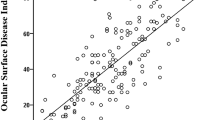Abstract
Background
To compare the symptom scores of children with those of adults with the same degree of mild ocular surface signs.
Methods
This study included patients with at least one ocular surface symptom and sign. Data obtained from 45 subjects aged 8.79 ± 2.95 yr (Mean ± SD) (pediatric group) and 45 adults aged 52.87 ± 10.87 yr (adult group) who were matched to each pediatric patient based on ocular surface signs were analyzed. Demographic data including age and sex; parameters of ocular surface signs including fluorescein staining score, tear film breakup time and Schirmer test score; symptom scores including ocular surface disease index (OSDI) and visual analog scale (VAS) were assessed and compared between the two groups.
Results
Significant differences emerged in sex ratio as well as in age between the two groups (P < 0.001, for both). Regarding ocular surface signs and tear film tests, the study revealed no significant differences in fluorescein staining score (1.44 ± 1.95 vs. 1.40 ± 1.68 P = 0.913), tear film break up time (4.96 ± 1.94 vs. 3.82 ± 1.85 s, P = 0.612) and Schirmer score (12.79 ± 9.05 vs. 10.11 ± 8.45 mm / 5 min, P = 0.370). Regarding dry eye symptoms, both OSDI and VAS were significantly lower in the pediatric group (P = 0.001 and < 0.001, respectively) than in the adult group.
Conclusion
Pediatric patients with mild ocular surface damage may report fewer dry eye symptoms compared to adult patients with similar stages of ocular surface damage.

Similar content being viewed by others
References
Research in dry eye: report of the Research Subcommittee of the International Dry Eye WorkShop (2007). Ocul Surf 5: 179-193
Management and therapy of dry eye disease: report of the Management and Therapy Subcommittee of the International Dry Eye WorkShop (2007). Ocul Surf 5: 163-178
The epidemiology of dry eye disease: report of the Epidemiology Subcommittee of the International Dry Eye WorkShop (2007). Ocul Surf 5: 93-107
Alves M, Dias AC, Rocha EM (2008) Dry eye in childhood: epidemiological and clinical aspects. Ocul Surf 6:44–51
Doughty MJ, Fonn D, Richter D, Simpson T, Caffery B, Gordon K (1997) A patient questionnaire approach to estimating the prevalence of dry eye symptoms in patients presenting to optometric practices across Canada. Optom Vis Sci 74:624–631
Mac Cord Medina F, Silvestre de Castro R, Leite SC, Rocha EM, de Melo RG (2007) Management of dry eye related to systemic diseases in childhood and longterm follow-up. Acta Ophthalmol Scand 85:739–744
Greiner KL, Walline JJ (2010) Dry eye in pediatric contact lens wearers. Eye Contact Lens 36:352–355
Han SB, Hyon JY, Woo SJ, Lee JJ, Kim TH, Kim KW (2011) Prevalence of dry eye disease in an elderly Korean population. Arch Ophthalmol 129:633–638
Lekhanont K, Rojanaporn D, Chuck RS, Vongthongsri A (2006) Prevalence of dry eye in Bangkok, Thailand. Cornea 25:1162–1167
Schiffman RM, Christianson MD, Jacobsen G, Hirsch JD, Reis BL (2000) Reliability and validity of the Ocular Surface Disease Index. Arch Ophthalmol 118:615–621
Vitale S, Goodman LA, Reed GF, Smith JA (2004) Comparison of the NEI-VFQ and OSDI questionnaires in patients with Sjogren's syndrome-related dry eye. Health Qual life Outcome 2:44
Han SB, Hyon JY, Wee WR, Lee JH, Lee YJ, Yun PY (2010) Reduced corneal sensitivity in patients with primary Sjogren's syndrome. Acta Ophthalmol 88:e277–278
van Bijsterveld OP (1969) Diagnostic tests in the Sicca syndrome. Arch Ophthalmol 82:10–14
Akinci A, Cakar N, Uncu N, Kara N, Acaroglu G (2007) Keratoconjunctivitis sicca in juvenile rheumatoid arthritis. Cornea 26:941–944
Wolkoff P, Nojgaard JK, Troiano P, Piccoli B (2005) Eye complaints in the office environment: precorneal tear film integrity influenced by eye blinking efficiency. Occup Environ Med 62:4–12
Begley CG, Caffery B, Nichols KK, Chalmers R (2000) Responses of contact lens wearers to a dry eye survey. Optom Vis Sci 77:40–46
Lin PY, Tsai SY, Cheng CY, Liu JH, Chou P, Hsu WM (2003) Prevalence of dry eye among an elderly Chinese population in Taiwan: the Shihpai Eye Study. Ophthalmology 110:1096–1101
Nichols KK, Nichols JJ, Mitchell GL (2004) The lack of association between signs and symptoms in patients with dry eye disease. Cornea 23:762–770
Acknowledgment
This study was supported by a grant from the Korea Healthcare Technology R&D Project, Ministry of Health and Welfare, Republic of Korea (A102065-24).
Financial disclosure
None.
Conflict of interest
None.
Author information
Authors and Affiliations
Corresponding author
Rights and permissions
About this article
Cite this article
Han, S.B., Yang, H.K., Hyon, J.Y. et al. Children with dry eye type conditions may report less severe symptoms than adult patients. Graefes Arch Clin Exp Ophthalmol 251, 791–796 (2013). https://doi.org/10.1007/s00417-012-2097-2
Received:
Revised:
Accepted:
Published:
Issue Date:
DOI: https://doi.org/10.1007/s00417-012-2097-2




